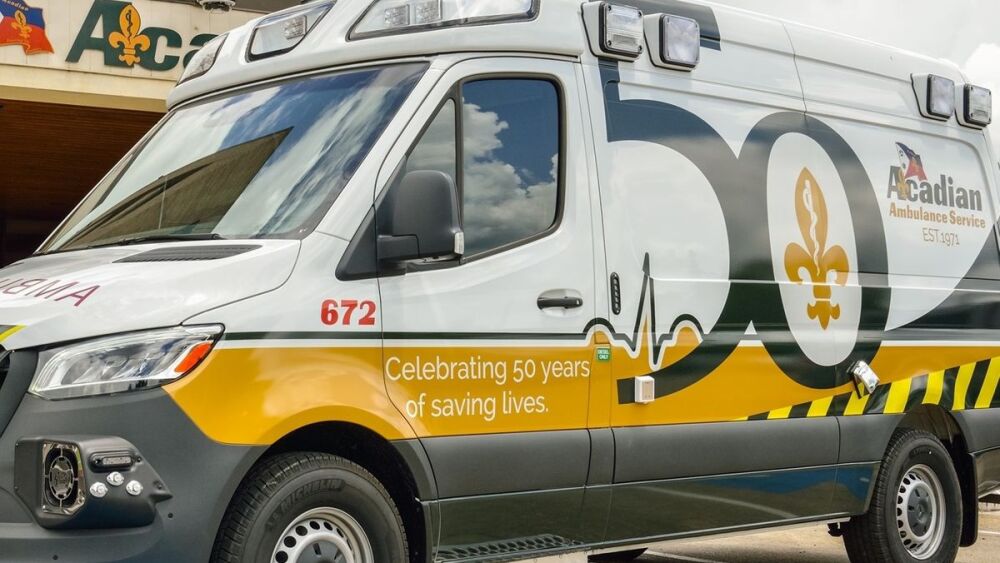Megan Wyatt
The Advocate, Baton Rouge, La.
BATON ROUGE, La. — Our Lady of Lourdes Regional Medical Center is expecting to reach the final and most critical phase of its seven-phase surge plan by the end of the week.
Ochsner Lafayette General Medical Center is receiving federal staffing assistance as soon as next week.
Acadian Ambulance is preparing medics to treat some patients at home instead of transporting them to hospitals.
These were a few of the stark realities shared by Acadiana’s healthcare leaders during a Wednesday afternoon video briefing in response to the rapid rise in coronavirus cases, hospitalizations and deaths as the delta variant continues to spread unabated through the region.
“We’re not seeing any slow down. We’re not seeing a turn around in any of these trends in the near future,” said Dr. Tina Stefanski, Acadiana’s top public health official. “So what that tells us is that if we don’t really come together as a community, we’re going to continue to see these increases and continue to see this transmission grow.”
Lourdes had 100 coronavirus patients at its main hospital campus as of Wednesday, which accounted for about 54% of the hospital’s total patient capacity. The hospital’s intensive care unit has been doubled under the current surge operations — from 24 beds to 48 beds — and between five to 10 critically ill patients at any given time are boarding in the hospital’s emergency department and surgery recovery rooms while waiting for ICU beds.
Lourdes is expected to reach 120 coronavirus patients by Sunday based on current admissions and discharges, according to the hospital’s interim chief medical officer. That would mean COVID-19 patients accounted for about 65% of the hospital’s capacity and would activate the seventh and final stage of the crisis care plan Dr. Henry Kaufman said he never expected to use.
“We set that number a long time ago at around 120 patients never thinking that we would get to that point,” Kaufman said. “We prayed that we would never get to that point. And now we’re faced with an oppressive reality of hitting that number in just four short days. And we will manage. We will find ways to care for the patients that are under our care, but I’m afraid that it won’t be to the standards that we generally hold ourselves to.”
Patients will be triaged as resources grow even more scarce, Kaufman said. Nurses will care for more people, and response times will be dramatically different.
The situation at Ochsner Lafayette General is marginally better in terms of the COVID-19 patient ratio at the main campus, but the smaller hospitals in the Acadiana system are at a similar breaking point as Lourdes. The main hospital is accepting virtually no patient transfers from smaller hospitals because every ICU bed and hospital bed is full with patients coming directly to the emergency department.
“We are also working with some federal relief to get some people into our health system to help us out with inpatients,” said Dr. Amanda Logue, chief medical officer for Ochsner Lafayette General. “So we are expecting a team coming to us possibly as early as next week to open up more beds in the hospital, the main campus, that will allow us to relieve some of the patients that are waiting for beds from the ER or from the ICU and hopefully be able to reduce a little bit of the congestion. We won’t have them forever, but we will take the help.”
About 35 to 40% of people transported by Acadian Ambulance are now COVID-19 positive, according to the company’s medical director, Dr. Chuck Burnell.
Acadian medics have been spending more time with each patient because hospitals often times have no available emergency department beds. Burnell said the company is prepared to treat patients on site instead of transporting them to hospitals as the situation grows more dire.
“I suspect it is coming and what we do in that situation is basically try to do what’s called a tiered response where we look at the acuity levels, just as you would in a hospital or hospital clinic environment,” Burnell said. “And the ones that don’t mandate transport to a hospital — to try to unclog that system, we’d either treat those people in place or leave them on site and refuse a transport.”
The Louisiana Emergency Response Network, which works with first responders and hospitals to quickly get patients to the best treatment facility available, exceeded 1,600 patients in a month at its call center for the first time in 12 years as a result of the fourth and worst wave of the pandemic, according to LERN Executive Director Paige Hargrove.
“For some patients, they’re calling up to 30 hospitals before they get someone to accept,” Hargrove said.
Acadiana’s healthcare leaders stressed that those experiencing emergencies, such as a heart attack or stroke, should still seek care immediately.
Those looking to get tested for COVID-19 should visit local clinics or pharmacies instead of emergency rooms to avoid further crowding hospitals and urgent care facilities. Those who test positive for COVID-19, whether vaccinated or unvaccinated, may be eligible to receive a monoclonal antibody infusion that can significantly improve symptoms and reduce the likelihood of hospitalization. People should contact their healthcare provider to learn more about eligibility requirements and scheduling.
Although a recent uptick in vaccinations is promising, it won’t immediately relieve the burden healthcare workers are currently facing. The leaders on Wednesday’s call urged people to wear masks and stop gathering in addition to getting vaccinated.
“I know of no plans for a lockdown,” Stefanski said. “We’re not helpless in this pandemic at this point. We know that vaccinations work. They’re effective at preventing hospitalizations and deaths, and we know that masks help to decrease transmission in the immediate phase. We hope that people realize the importance of doing both of those and, of course, keeping gatherings to a minimum.”
___
(c)2021 The Advocate












